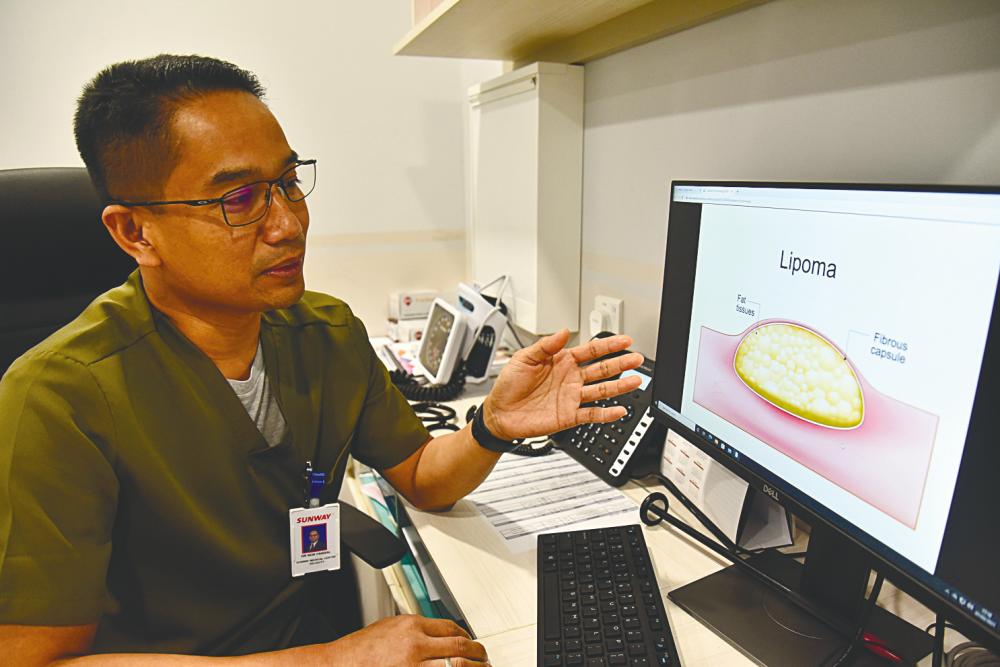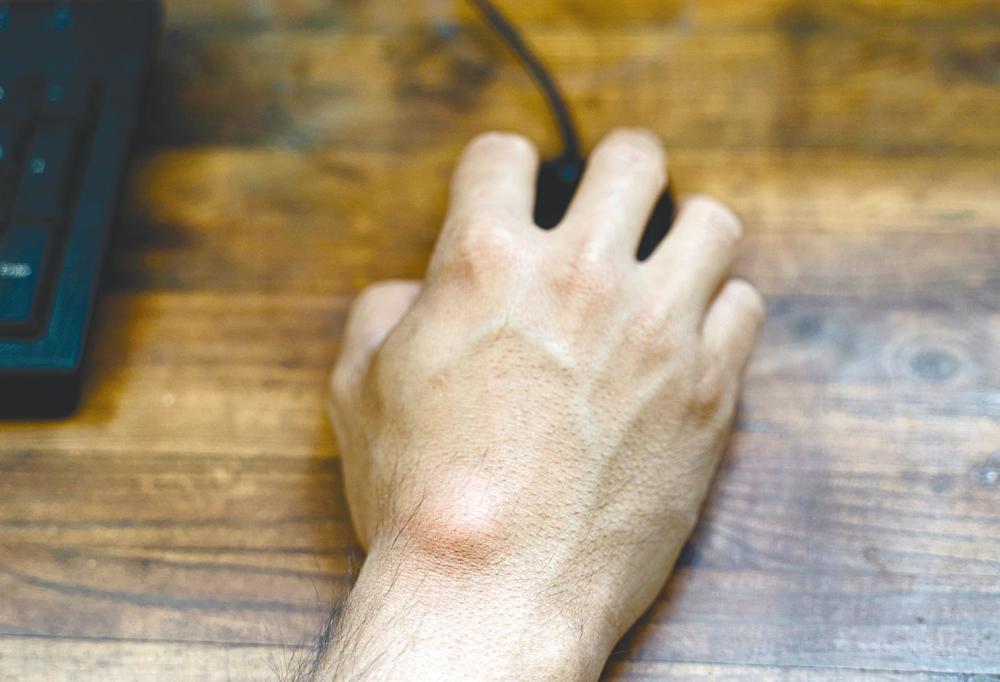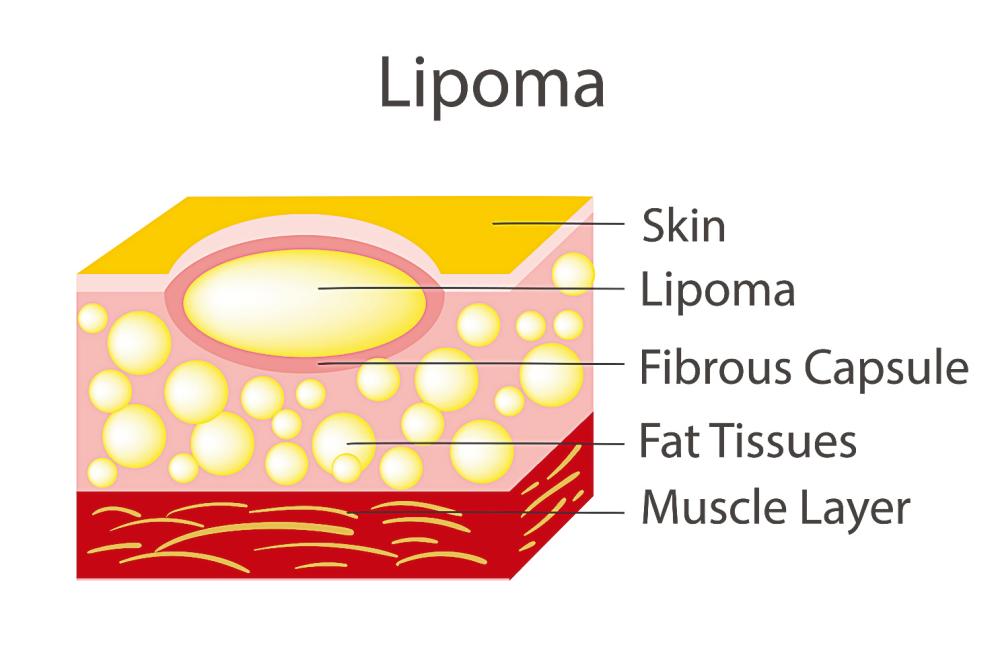The dangers of lipoma
20 March 2023

Dr Nor Faissal explaining about lipoma.
DO you ever encounter a bump or lump in your arms, legs, or any other part of your body and never even bother to seek medical attention? Well, the bump on the body is called a lipoma (if you have seen Dr. Pimple Popper, a TV series on Astro about a doctor changing people’s lives by removing lipomas through surgery, you would be familiar with the term).
Lipoma is a fatty soft tissue that forms beneath the skin and surfaces in an odd or round shape. Lipomas typically grow over time. During its initial stage, it may appear harmless due to its soft content, and is moveable. Most people would not bother about it until, of course, a much later stage when the size is noticeably larger.
As it grows, a lipoma starts affecting the surrounding nervous system and movements, which may get in the way of doing ordinary things. For example, a lipoma on the wrist may obstruct writing or typing on a laptop. Due to the condition, a larger size of clothing is needed to accommodate or hide the abnormal bump, and even worse, it could be a cancerous tumour.
But first, what is lipoma?
“A lipoma is a fat lump,” according to Associate Professor Dr. Nor Faissal Yasin, an orthopaedic oncology surgeon at Sunway Medical Centre Velocity (SMCV). “Lipoma is a benign soft tissue tumour that grows under the skin, and the bump is easily noticeable. It will appear like a swelling, and is painless when pressed.
“Lipoma can grow in one big lump or multiple lumps. Usually, a lipoma becomes bigger over a very long time, commonly more than six months.”
Nor Faissal explained that when lipoma is put under the microscope, it appears as just normal fat cells, but it multiplies in large amounts for some reason; the actual cause, however, is still unknown.
As the lipoma grows bigger, it could cause discomfort and affect the surrounding muscles, nerves and movements of joints, and in rare cases, blood vessels.
“For example, lipoma around the wrists could press on the nerves and cause numbness,” said Nor Faissal. Some lipomas can also develop inside the abdomen. Lipoma commonly develops in anyone, from young to old.
“There is no specific age group in which anyone can be affected, but it has a tendency to grow among those, who are obese and overweight. However, thin patients can have it, too,” said Nor Faissal.
Some diabetic patients may get these bumps, although, according to Nor Faissal lipoma is not connected to diabetes. Normally, the body will fight against abnormal tissue, but because lipoma is non-cancerous and not a threat, it will only fight when it turns into a cencerous cell or liposarcoma.

(left) Athough lipoma and liposarcoma do appear similar, liposarcoma is cancerous.
Types of lipoma
There are a few types of lipomas: conventional lipoma, fibrolipoma, hibernoma, pleomorphic lipoma, and spindel cell lipoma, but the most aggressive ones are called atypical lipomas and angiolipoma.
Atypical lipomas contain a large amount of cells, which multiply continuously, while angiolipoma has a lot of blood vessels that supply blood and fat cells.
“Atypical lipoma appears benign, but it keeps coming back and has a high recurrence rate. When you remove a lipoma, it comes back,” Nor Faissal said.
“Angiolipomas are benign, but they are very vascular, which means there is a lot of blood vessel supply. When a doctor removes an angiolipoma, it would easily bleed.”
Lipoma turns liposacorma
Lipoma is non-life threatening, however, lipoma can turn into liposarcoma, which is a cancerous tumour. But one wonders how it would change. “Liposarcoma is a malignant cancer of soft tissue and a cancerous form of fat cells,” revealed Nor Faissal.
“Over time, a lipoma can grow to become cancerous. From painless, it could turn painful, and when it changes its characteristics, you should seek medical help, immediately.”
Nor Faissal explained that a small lipoma would have a non-active cell, and thus, there is no pain. However, when the lipoma grows bigger and bigger, the cells in the lipoma become active, causing pain.”
Another warning sign is when the lump is larger than 5 cm in diameter, deep inside the muscle, hard, and immobile, then, there is a high risk of it being a cancerous liposarcoma.
“Any lump with more than 5 cm in diameter is always a risk, and it’s better to remove a lipoma at an early stage when it’s still small in size,” advised Nor Faissal.
Lipoma and liposarcoma appear the same on the skin, and it is difficult to differentiate them as both are large and the results of an MRI or ultra sound may be the same. Lipoma can be removed through a simple procedure called ‘excisional biopsy’, which means making an incision to remove the fat cells swelling together with its capsule.
However, for liposarcoma, a ‘wide excision surgery’ performed to remove the entire capsule, along with one or two centimetres of soft tissue in the surrounding area.
“In some surgeries, if the liposarcoma is attached to a muscle or tendon, a portion of the muscle or tendon (that is exposed to cancer cells) had to be removed as well,” Nor Faissal explained.
The exposed cancer cells and healthy tissues in the surrounding area are removed in their entirety, leaving only the non-cancerous cells to avoid any contamination or recurrence, which is termed as “wide excision’.
After the surgery, the second stage would be giving radiotherapy treatment to the surrounding surgical area to reduce the risk of recurrence.

(below) Checking a lipoma at an early stage is always better.
Early detection saves lives
“It is critical to detect liposarcoma early in order to avoid any spread to other organs,” said Nor Faissal.
“If you have any swelling, that is painful, big, and more than 5cm, consult a specialist immediately because it could just be a benign or worse, a cancerous swelling.” he stressed.
“Removing it at an early stage is better than at a later stage. It’s better to remove it when it’s still small. The bigger the size,the more difficult to remove it and it is associated with higher of complications,” said Nor Faissal.
Besides, a small surgery will take less than half an hour under anaesthesia as it would be a daycare procedure, but a surgery for a big lump may take hours.
However, Nor Faissal noticed that there is a lack of awareness about lipoma or liposarcoma compared to other types of cancer. He hopes that there is more awareness about lipoma and liposarcoma.
People tend to take it lightly when they notice a bump because there is no pain.
So, the next time you notice a bump on your body, check it immediately.
Kembali



